Bumthang
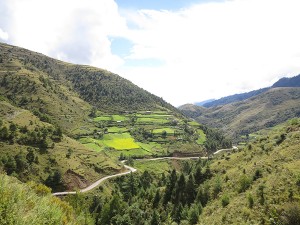 My next destination was Jakar which is in the Bumthang province. It’s a 7 hour drive away from Phobjikha, so we started driving early in the morning. The drive was very beautiful, I am so amazed at how lush green Bhutan is. 70% of Bhutan’s surface is covered by forest, and actually the king set a rule that they will never cut down more than 40% of the forest in Bhutan. The king is definitely an environmentalist.
My next destination was Jakar which is in the Bumthang province. It’s a 7 hour drive away from Phobjikha, so we started driving early in the morning. The drive was very beautiful, I am so amazed at how lush green Bhutan is. 70% of Bhutan’s surface is covered by forest, and actually the king set a rule that they will never cut down more than 40% of the forest in Bhutan. The king is definitely an environmentalist.
 On the drive, we also visited the Trongsa dzong. Similarly to the one in Thimphu, the dzong was half government buildings and half monastery. It’s in a beautiful setting on a cliff with a waterfall on its right side. As I said before, all of Bhutan just seems like one gigantic nature reserve.
On the drive, we also visited the Trongsa dzong. Similarly to the one in Thimphu, the dzong was half government buildings and half monastery. It’s in a beautiful setting on a cliff with a waterfall on its right side. As I said before, all of Bhutan just seems like one gigantic nature reserve.
We arrived in Jakar in the late afternoon. Jakar is a tiny little town that seems to mostly have guesthouses, restaurants and bars. I was told that most of Jakar burnt down a few years ago and so the town was newly rebuilt. Bhutan seems to also have to deal with a number of natural disasters, in particular earthquakes leading to fires. I have been told multiple times now that a historic monument or an entire city was destroyed by an earthquake fire, Jakar being one of them.
There are a large number of temples and other historic buildings around Jakar, so that is what we went to see on the second day. We started out by visiting the dzong of Bumthang (again, the building is half government, half monastery). We then visited a beautiful building that used to be the palace from where the first king ruled before he was a king. What made the building so beautiful were all the deep blue decorative paintings on the walls. Our final stop in the morning was Tamzhing Lhakhang which is a temple that was built in the 15th century. The monks and other villagers were having lunch on the grass around the temple while we were visiting the area.
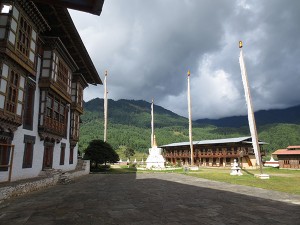 In the early afternoon, we visited Kurjey Lhakhang which is the most holy place in Bhutan. Guru Padmasambhava meditated there and left the imprint of his body on the enshrined rock. There are two additional temples next to Kurjey Lhakhang which were built in more recent years. We were sitting around for a while in the temple and so the caretaker of the temple offered us potato chips. Apparently, once an offering has been made to the temple, the caretaker is free to redistribute the offerings. It felt a bit contradictory to be eating chips at the most holy place in Bhutan, but one of many superstitious rules in Bhutan is that you never say no to a monk.
In the early afternoon, we visited Kurjey Lhakhang which is the most holy place in Bhutan. Guru Padmasambhava meditated there and left the imprint of his body on the enshrined rock. There are two additional temples next to Kurjey Lhakhang which were built in more recent years. We were sitting around for a while in the temple and so the caretaker of the temple offered us potato chips. Apparently, once an offering has been made to the temple, the caretaker is free to redistribute the offerings. It felt a bit contradictory to be eating chips at the most holy place in Bhutan, but one of many superstitious rules in Bhutan is that you never say no to a monk.
After visiting the three temples, we took a short path behind the temple to a dwell where one could obtain holy water. It was interesting to see people wash their hands and hair with this water. My guide also used it to fill our water bottles.
After visiting Kurjey Lhakhang, we took a beautiful walk across the river to see Jambay Lhakhang. Jambay Lhakhang is another temple/monastry. Legend says that it is part of a group of 108 temples that were all built on the same day across the Himalayas. From this collection of temples only two remain, one in Jakar and one in Paro (Tiger’s Nest). Inside of the temple, there is an iron drape which weighs around 20kg. One has to carry it around the temple three times to free yourself of sins and for good luck. Sarap carried it around for one round and I did all three rounds, so now rumor has it good things will happen during our Bhutan tour.
 I am really amazed by how superstitious Bhutanese are. I always thought that Buddhism is extremely simple without deities and other mythological figures. I didn’t realize that there was this branch of Buddhism which is practiced in Tibet and Bhutan that is extremely complicated and shares some similarities with Hinduism. People believe in many evil powers and deities and there are strict rules on how everyone has to behave in order to have good luck. For example, you should always circle a room in clockwise order, when given a colored string by a monk, you need to tie it around your neck or arm and leave it there until it falls off, dogs need to be kept outside to fight off the evil spirits when barking, people also consult gurus to determine where to build a house or when to abandon building a house (you see many half finished houses along the road that people abandoned building). As far as I can tell, following all of these rules is really complex.
I am really amazed by how superstitious Bhutanese are. I always thought that Buddhism is extremely simple without deities and other mythological figures. I didn’t realize that there was this branch of Buddhism which is practiced in Tibet and Bhutan that is extremely complicated and shares some similarities with Hinduism. People believe in many evil powers and deities and there are strict rules on how everyone has to behave in order to have good luck. For example, you should always circle a room in clockwise order, when given a colored string by a monk, you need to tie it around your neck or arm and leave it there until it falls off, dogs need to be kept outside to fight off the evil spirits when barking, people also consult gurus to determine where to build a house or when to abandon building a house (you see many half finished houses along the road that people abandoned building). As far as I can tell, following all of these rules is really complex.
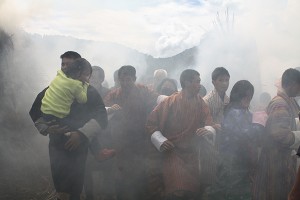 On my second day in Bumthang, we went to see the Tangbi Mani festival. During this festival, they perform what is called the fire blessing. Some monk dancers perform the same masked dances that I already saw at the tsechu, but then they also lit two large fires. The general population then needs to run three times between the two fires in order to be blessed. I first wasn’t too thrilled about the festival as there seemed to be more tourists than locals. But once they put on the fire, complete chaos prevailed. People came from nowhere and were running all over the place. It was muddy and of course everyone was dressed traditionally. The whole atmosphere made it seem like we had gone back in time… Although I find Bhutanese very open-minded and modern, their dress code and numerous religious superstitions often makes me feel as if their culture and traditions has remained intact since the middle ages.
On my second day in Bumthang, we went to see the Tangbi Mani festival. During this festival, they perform what is called the fire blessing. Some monk dancers perform the same masked dances that I already saw at the tsechu, but then they also lit two large fires. The general population then needs to run three times between the two fires in order to be blessed. I first wasn’t too thrilled about the festival as there seemed to be more tourists than locals. But once they put on the fire, complete chaos prevailed. People came from nowhere and were running all over the place. It was muddy and of course everyone was dressed traditionally. The whole atmosphere made it seem like we had gone back in time… Although I find Bhutanese very open-minded and modern, their dress code and numerous religious superstitions often makes me feel as if their culture and traditions has remained intact since the middle ages.
Together with every festival, there was of course also a gambling section. I really enjoy watching locals play all sorts of games. It is also the only time when monks are allowed to play. Especially teenage monks seemed to be having a lot of fun.
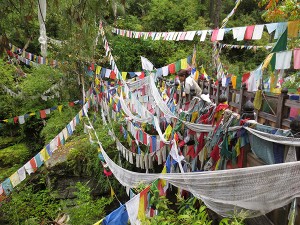 In the afternoon, we went to visit Mebartsho (Flaming Lake) in the Tang Valley. The flaming lake is a river where Terton Perma Lingpa found a statue that had been hidden by Guru Padmasambhava. Legend has it that Perma Lingpa dived into the river with a candle and resurfaced with a golden statue in one hand and the still lit candle in the other hand. Since then, the location has become a holy site.
In the afternoon, we went to visit Mebartsho (Flaming Lake) in the Tang Valley. The flaming lake is a river where Terton Perma Lingpa found a statue that had been hidden by Guru Padmasambhava. Legend has it that Perma Lingpa dived into the river with a candle and resurfaced with a golden statue in one hand and the still lit candle in the other hand. Since then, the location has become a holy site.
 From the Flaming Lake we drove deeper into the Tang Valley. Sadly, it was raining but I could still make out how beautiful this valley must be. We then visited a nunnery in the valley. All but two nuns were at the festival, so the monastery seemed completely deserted. The nun offered us tea and cookies. I was surprised to also see a tiny little child who had just become a nun. The child must have been 5-6 years old. Her head was shaven and she was wearing a red drape. Apparently that particular nun was the youngest one in the nunnery.
From the Flaming Lake we drove deeper into the Tang Valley. Sadly, it was raining but I could still make out how beautiful this valley must be. We then visited a nunnery in the valley. All but two nuns were at the festival, so the monastery seemed completely deserted. The nun offered us tea and cookies. I was surprised to also see a tiny little child who had just become a nun. The child must have been 5-6 years old. Her head was shaven and she was wearing a red drape. Apparently that particular nun was the youngest one in the nunnery.
I then ended the day by taking a walk around Jakar. Many locals smiled at me and greeted me. They seemed to be happy to have a tourist around and were proud to show me what they had planted in their fields. Some people talked to me for a long time, despite the fact that I could not understand them. Many people also commented on me walking far away. Since most Bhutanese are farmers, they are always outside for a reason. So they don’t fully understand how Westerners walk outside without specific purpose just to get some exercise.
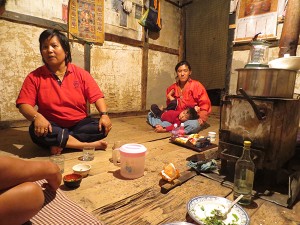 In the evening, Sarap picked me up to go and have tea at her cousins. She warned me that her cousin’s place would be very simple and not so clean. I told her not to worry about it. I much prefer staying/visiting locals rather than spending time in the hotel. The house of Sarap’s cousin was indeed very simple. It had four rooms. One living room, one room where there was the oven and people would eat around the oven, one bedroom and the kitchen. Most rooms didn’t have any furniture and we all sat and ate on the floor. I ended up staying for dinner and drinks. Bhutanese drink a lot, every third building here seems to be a bar. The problem when drinking with Bhutanese is that one cannot have only one glass, because that would be bad luck. There is an auspicious number for everything, including drinking. So we ended up finishing an non distilled bottle of plum brandy among the four of us. We had a good time and I was able to ask them all kind of questions about Bhutanese life and politics.
In the evening, Sarap picked me up to go and have tea at her cousins. She warned me that her cousin’s place would be very simple and not so clean. I told her not to worry about it. I much prefer staying/visiting locals rather than spending time in the hotel. The house of Sarap’s cousin was indeed very simple. It had four rooms. One living room, one room where there was the oven and people would eat around the oven, one bedroom and the kitchen. Most rooms didn’t have any furniture and we all sat and ate on the floor. I ended up staying for dinner and drinks. Bhutanese drink a lot, every third building here seems to be a bar. The problem when drinking with Bhutanese is that one cannot have only one glass, because that would be bad luck. There is an auspicious number for everything, including drinking. So we ended up finishing an non distilled bottle of plum brandy among the four of us. We had a good time and I was able to ask them all kind of questions about Bhutanese life and politics.
The dinner that we had that evening was basically rice with chili. I love spicy food, but there is a type of chili that seems to be even too strong for me. At some point during my trip, I started having open wounds on my tongue. I figured I must have bitten myself in the tongue while sleeping. It turns out that it’s a certain type of chili that causes these open wounds. I actually didn’t know that this was possible, but whenever I am eating this super strong chili, I have blisters on my tongue within a couple of hours. Crazy…. So now I am staying away from chili altogether…
See more pictures here for the journey to Bumthang, and here for Bumthang itself.
This entry was posted on Monday, February 10th, 2014 at 1:45 am and is filed under Travel Stories. You can follow any responses to this entry through the RSS 2.0 feed.









